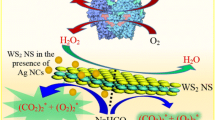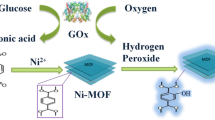Abstract
The authors describe a fluorometric glucose assay that is based on the use of MnO2 nanosheets and copper nanoclusters (CuNCs) acting as nanoprobes. The CuNCs were synthesized by using bovine serum albumin as a template by chemical reduction of copper(II) sulfate. On addition of MnO2 nanosheets to a colloidal solution of CuNCs, the fluorescence of CuNCs (measured at excitation/emission wavelengths of 335/410 nm) is quenched. However, in the presence of enzymatically generated H2O2, the MnO2 nanosheets are reduced to form Mn(II) ions. As a result, fluorescence intensity recovers. The glucose assay is based on the enzymatic conversion of glucose by glucose oxidase to generate H2O2 and glucuronic acid. The calibration plot is linear in the 1 μM to 200 μM glucose concentration range, and the detection limit is 100 nM. The method was successfully applied to the determination of glucose in spiked human serum samples.

A sensitive fluorescent bioassay is reported for the detection of glucose based on the hydrogen peroxide-induced decomposition of a quencher system composed of MnO2 nanosheets and copper nanoclusters (CuNCs).







Similar content being viewed by others
References
Wang GF, He XP, Wang LL, Gu AX, Huang Y, Fang B, Geng BY, Zhang XJ (2013) Non-enzymatic electrochemical sensing of glucose. Microchim Acta 180:161–186
Steiner MS, Duerkop A, Wolfbeis OS (2011) Optical methods for sensing glucose. Chem Soc Rev 40:4805–4839
Chang Q, Tang HQ (2014) Optical determination of glucose and hydrogen peroxide using a nanocomposite prepared from glucose oxidase and magnetite nanoparticles immobilized on graphene oxide. Microchim Acta 181:527–534
Shen P, Xia Y (2014) Synthesis-modification integration: one-step fabrication of boronic acid functionalized carbon dots for fluorescent blood sugar sensing. Anal Chem 86:5323–5329
Wang N, Sun JC, Chen LJ, Fan H, Ai SY (2015) A Cu2(OH)3Cl-CeO2 nanocomposite with peroxidase-like activity, and its application to the determination of hydrogen peroxide, glucose and cholesterol. Microchim Acta 182:1733–1738
Ding CP, Yan YH, Xiang DS, Zhang CL, Xian YZ (2016) Magnetic Fe3S4 nanoparticles with peroxidase-like activity, and their use in a photometric enzymatic glucose assay. Microchim Acta 183:625–631
Bostick DT, Hercules DM (1975) Quantitative determination of blood glucose using enzyme induced chemiluminescence of luminol. Anal Chem 47:447–452
Nie HG, Yao Z, Zhou XM, Yang Z, Huang SM (2011) Nonenzymatic electrochemical detection of glucose using well-distributed nickel nanoparticles on straight multi-walled carbon nanotubes. Biosens Bioelectron 30:28–34
Li ZJ, Sheng LY, Meng AL, Xie CC, Zhao K (2016) A glassy carbon electrode modified with a composite consisting of reduced graphene oxide, zinc oxide and silver nanoparticles in a chitosan matrix for studying the direct electron transfer of glucose oxidase and for enzymatic sensing of glucose. Microchim Acta 183:1625–1632
Derfus AM, Chan WCW, Bhatia SN (2004) Probing the cytotoxicity of semiconductor quantum dots. Nano Lett 4:11–18
Katstumiti A, Gilliland D, Arostegui I, Cajaraville MP (2014) Cytotoxicity and cellular mechanisms involved in the toxicity of CdS quantum dots in hemocytes and gill cells of the mussel Mytilus galloprovincialis. Aquat Toxicol 153:39–52
Ge J, Ou EC, Yu RQ, Chu X (2014) A novel aptameric nanobiosensor based on the self-assembled DNA-MoS2 nanosheet architecture for biomolecule detection. J Mater Chem B 2:625–628
Xi Q, Zhou DM, Kan YY, Ge J, Wu ZK, Yu RQ, Jiang JH (2014) Highly sensitive and selective strategy for microRNA detection based on WS2 nanosheet mediated fluorescence quenching and duplex-specific nuclease signal amplification. Anal Chem 86:1361–1365
Li N, Diao W, Han YY, Pan W, Zhang TT, Tang B (2014) MnO2-modified persistent luminescence nanoparticles for detection and imaging of glutathione in living cells and in vivo. Chem Eur J 20:16488–16491
Cai QY, Li J, Ge J, Zhang L, Hu YL, Li ZH, Qu LB (2015) A rapid fluorescence “switch-on” assay for glutathione detection by using carbon dots-MnO2 nanocomposites. Biosens Bioelectron 72:31–36
Wang YH, Jiang K, Zhu JL, Zhang L, Lin HW (2015) A FRET-based carbon dot-MnO2 nanosheet architecture for glutathione sensing in human whole blood samples. Chem Commun 51:12748–12751
Deng RR, Xie XJ, Vendrell M, Chang YT, Liu XG (2011) Intracellular glutathione detection using MnO2-nanosheet-modified upconversion nanoparticles. J Am Chem Soc 133:20168–20171
Yuan J, Cen Y, Kong XJ, Wu S, Liu CL, Yu RQ, Chu X (2015) MnO2-nanosheet-modified upconversion nanosystem for sensitive turn-on fluorescence detection of H2O2 and glucose in blood. ACS Appl Mater Interfaces 7:10548–10555
Zhang XL, Zheng C, Guo SS, Li J, Yang HH, Chen GN (2014) Turn-on fluorescence sensor for intracellular imaging of glutathione using g-C3N4 nanosheet-MnO2 sandwich nanocomposite. Anal Chem 86:3426–3434
Richards CI, Choi S, Hsiang JC, Antoku Y, Vosch T, Bongiorno A, Tzeng YL, Dickson RM (2008) Oligonucleotide-stabilized Ag nanocluster fluorophores. J Am Chem Soc 130:5038–5039
Hong ML, Li LJ, Han HX, Chu X (2014) A label-free fluorescence assay for trypsin based on the electron transfer between oligonucleotide-stabilized Ag nanoclusters and cytochrome c. Anal Sci 30:811–815
Tian X, Kong XJ, Zhu ZM, Chen TT, Chu X (2015) A new label-free and turn-on strategy for endonuclease detection using a DNA-silver nanocluster probe. Talanta 131:116–120
Hu YH, Wu YM, Chen TT, Chu X, Yu RQ (2013) Double-strand DNA-templated synthesis of copper nanoclusters as novel fluorescence probe for label-free detection of biothiols. Anal Methods 5:3577–3581
Wang HB, Zhang HD, Chen Y, Huang KJ, Liu YM (2015) A label-free and ultrasensitive fluorescent sensor for dopamine detection based on double-stranded DNA templated copper nanoparticles. Sens Actuators B: Chem 220:146–153
Wang HB, Zhang HD, Chen Y, Liu YM (2015) A fluorescent biosensor for protein detection based on poly(thymine)-templated copper nanoparticles and terminal protection of small molecule-linked DNA. Biosens Bioelectron 74:581–586
Goswami N, Giri A, Bootharaju MS, Xavire PL, Pradeep T, Pal SK (2011) Copper quantum clusters in protein matrix: potential sensor of Pb2+ ion. Anal Chem 83:9676–9680
Gao Z, Su R, Qi W, Wang L, He Z (2014) Copper nanocluster-based fluorescent sensors for sensitive and selective detection of kojic acid in food stuff. Sens Actuators B: Chem 195:359–364
Hu LZ, Yuan YL, Zhang L, Zhao JM, Majeed S, Xu GB (2013) Copper nanoclusters as peroxidase mimetics and their applications to H2O2 and glucose detection. Anal Chim Acta 762:83–86
Nakayama M, Sato A, Yamaguchi R (2013) Decomposition and detection of hydrogen peroxide using δ-MnO2 thin film electrode with self-healing property. Electroanalysis 25:2283–2288
Ling Y, Zhang N, Qu F, Wen T, Gao ZF, Li NB, Luo HQ (2014) Fluorescent detection of hydrogen peroxide and glucose with polyethyleneimine-templated Cu nanoclusters. Spectrochim Acta A Mol Biomol Spectrosc 118:315–320
Yin YH, Deng JH, Zhang YY, Li HT, Yao SZ (2013) Label-free Si quantum dots as photoluminescence probes for glucose detection. Chem Commun 49:612–614
Liu JL, Lu LL, Li AQ, Tang J, Wang SG, Xu SY, Wang LY (2015) Simultaneous detection of hydrogen peroxide and glucose in human serum with upconversion luminescence. Biosens Bioelectron 68:204–209
He DH, Zheng CB, Wang Q, He CL, Lee YI, Wu L, Hou XD (2015) Dielectric barrier discharge-assisted one-pot synthesis of carbon quantum dots as fluorescent probes for selective and sensitive detection of hydrogen peroxide and glucose. Talanta 142:51–56
Huan YF, Fei Q, Shan HY, Wang BJ, Xu H, Feng GD (2015) A novel water-soluble sulfonated porphyrin fluorescence sensor for sensitive assays of H2O2 and glucose. Analyst 140:1655–1661
Wang HB, Zhang HD, Chen Y, Li Y, Gan T (2015) H2O2-mediated fluorescence quenching of double stranded DNA templated copper nanoparticles for label-free and sensitive detection of glucose. RSC Adv 5:77906–77912
Acknowledgements
This work was financially supported by National Natural Science Foundation of China (No. 21305119, 21375114), Nanhu Scholars Program for Young Scholars of XYNU, Plan For Scientific Innovation Talent of Henan Province.
Author information
Authors and Affiliations
Corresponding author
Ethics declarations
The author(s) declare that they have no competing interests.
Electronic supplementary material
ESM 1
(DOC 691 kb)
Rights and permissions
About this article
Cite this article
Wang, HB., Chen, Y., Li, N. et al. A fluorescent glucose bioassay based on the hydrogen peroxide-induced decomposition of a quencher system composed of MnO2 nanosheets and copper nanoclusters. Microchim Acta 184, 515–523 (2017). https://doi.org/10.1007/s00604-016-2045-7
Received:
Accepted:
Published:
Issue Date:
DOI: https://doi.org/10.1007/s00604-016-2045-7




